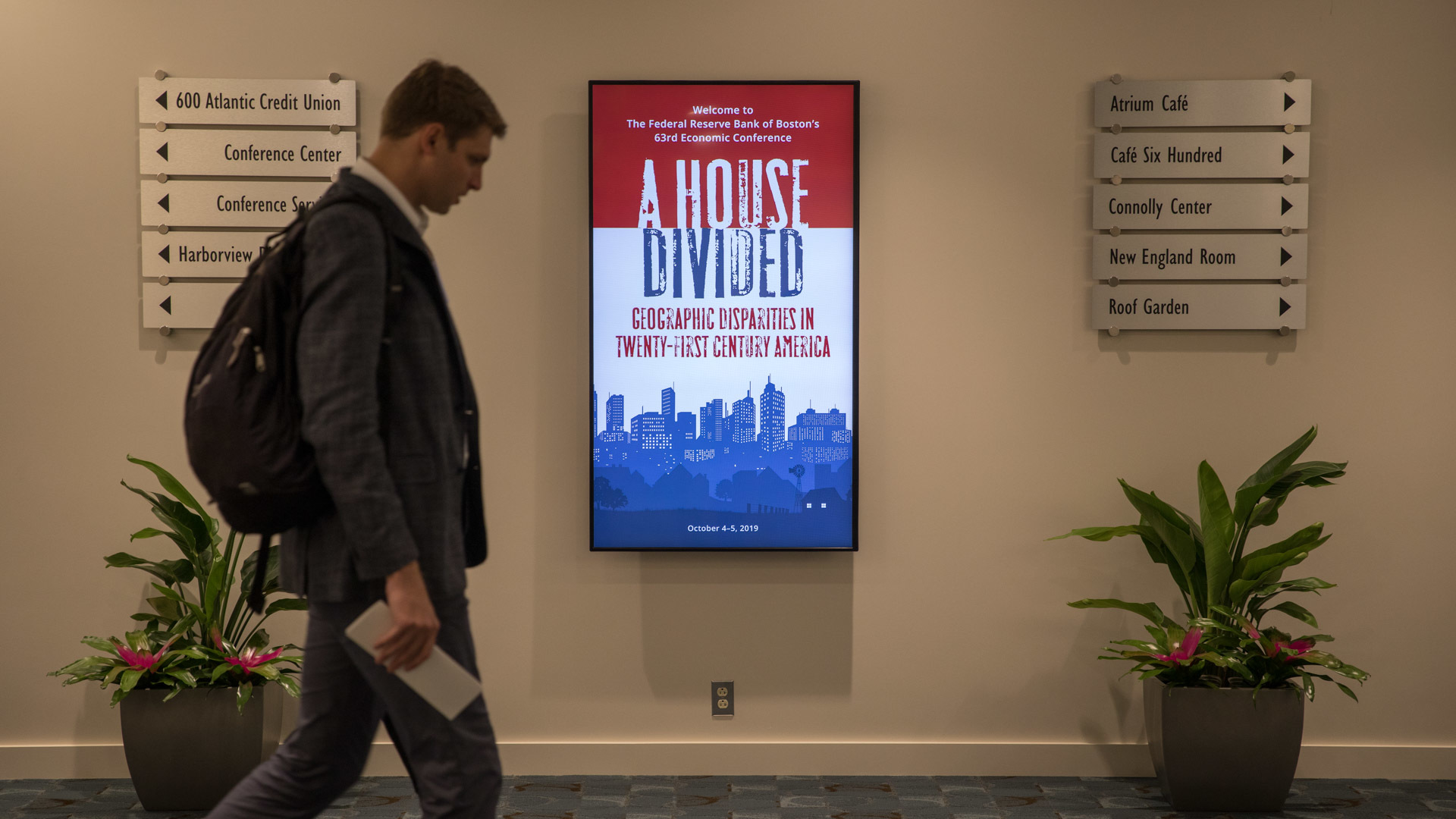As inequality between richer and poorer places persists, is it time to do things differently? 
63rd annual economic conference at Boston Fed examines geographic disparities, solutions 
Leading economists and central bankers met this weekend to discuss the increasingly entrenched prosperity gap between richer and poorer areas of the U.S. and whether policies that focus on “place,” rather than people, may be one way to close it.
“A House Divided: Geographic Disparities in Twenty-First Century America” was the title of The Federal Reserve Bank of Boston’s 63rd annual economic conference held on Friday and Saturday. Attendees shared perspectives and data on the causes of the gap, how it impacts access to quality health care and education, and what new policies could close the gap regionally and nationally.
In opening remarks, Boston Fed President Eric Rosengren said efforts to boost struggling communities over the last 50 years have largely failed. “We need new policies,” he said.
He added policymakers must get beyond simply trying to identify problems and trends and focus on solutions.
“I think in many cases, the problems are visual, and the solutions are less apparent,” he said.
Several trends have economists rethinking the role of place in economic policy
Economists have traditionally downplayed place, or geographic location, when looking to reduce inequality and increase economic opportunity. People are mobile, they argue, so the focus should instead be on improving an individual’s prospects by enhancing their skills, education, or buying power. But several trends have economists rethinking the importance of place:
- The gap in income distribution between poorer and richer states is not shrinking, after consistently narrowing during most of the 20th century.
- Migration from poorer to richer states, once a key way for individuals to improve their economic prospects after a regional economic shock, has slowed, and it’s unclear why.
- Housing costs in thriving areas have become prohibitive to workers in less prosperous places, which may be contributing to slowing interstate migration.
11 images

Economists, academics ask which place-based policies are most promising
The conference featured papers that addressed several dimensions of the U.S.’s geographic disparities, from differing labor market conditions to how much of the decline in interstate migration is related to local housing policies.
During a discussion on Saturday morning, Betsy Stevenson, a public policy professor at the University of Michigan, said any study of the disparity needs to start by trying to better understand what’s causing income inequality – specifically whether it's declining work or wage stagnation. She added that another important factor, and a harder one to get at, is what she sees as a growing decline in interpersonal trust. If people trust each other less, they’re less willing to help each other out and chip in for communal resources which could help close the prosperity gap, like a library or educational programs.
“We’re not trusting each other, and those declines terrify me,” Stevenson said.
Keynote speaker Paul Krugman, who won the Nobel Prize in part for his work on economic geography, said place-based policies are actually already in effect via the U.S. federal system, since the system transfers tax dollars from wealthier to poorer states through need-based federal entitlement programs, such as Medicaid.
“Without intending to, just by the rules of the game of our federal system, we’re already doing a hell of a lot to help (lagging U.S. regions), and it’s mitigating misery,” Krugman said. “It’s not actually managing to reverse the economic decline.”
Rosengren: It’s critical to test old assumptions and new approaches
The conference wrapped with a panel discussion, “Has the time for place-based policies finally arrived?” The panel considered policies such as federal tax incentives for development in less prosperous areas and what those incentives should target – economic growth, jobs, education, or something else?
Panelist and former U.S. Treasury Secretary Lawrence Summers said it’s increasingly important to understand the problems associated with geographic disparity. As proof, he cited recent developments he said can be tied to the disparity, from Brexit and the election of President Trump to the rise of Islamic radicalism in Turkey.
“It is the disaffection of distant non-cosmopolitans who live away from major prospering capital cities that is the source of populist nationalism, anti-internationalism, reduced global cooperation, and increased incentives certainly to trade wars, and possibly conflicts going well beyond trade wars around the world,” he said.
Rosengren said it’s critical for old assumptions to be tested and new approaches considered, especially when reality pulls in another direction.
“We know that these are tough questions, and we know we haven’t had a lot of success over the last 50 years,” he said. “That makes it all the more important for us to be even more focused on success going forward.”
Find the conference papers and video recordings of each session on the conference website.

 About the Authors
About the Authors
Jay Lindsay is a member of the communications team at the Federal Reserve Bank of Boston.
Email: jay.lindsay@bos.frb.org
Site Topics
Keywords
- income inequality ,
- inequality ,
- economic inequality ,
- Geographic disparities






